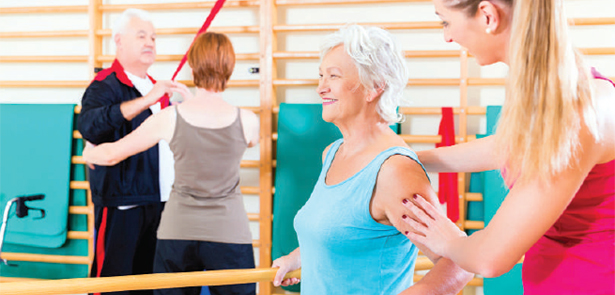Life after cancer

In one way or another, cancer affects us all – but we don’t have to take it sitting down. New Vivacity fitness classes specifically designed for those with or recovering from cancer provide the opportunity for sufferers to stay active, improve their quality of life and even help keep cancer at bay. Toby Venables looks at how exercise helps those with the disease – and how it can reduce the cancer risk for us all
“We are experiencing a cancer epidemic…”
So said a leading cancer expert to me at a seminar not long ago – and while it sounds scary, the figures certainly support his claim. Figures from Cancer Research UK show a 12% increase in the rate of cancer since the mid-90s – that’s more than 352,000 people now being diagnosed with cancer in the UK each year compared with around 253,000 two decades ago. We don’t have to look far to see the effects, either. Everyone knows someone who has suffered the disease – many of us will have been involved in some form of fundraising for a friend or colleague. If that wasn’t enough, 2016 has seen a seemingly endless succession of cultural figures succumb to cancer including David Bowie, Alan Rickman, Terry Wogan, Victoria Wood and Caroline Aherne. But, while it rarely makes the headlines, there is good news, too. Survival rates are increasing. We may not have a cure yet, but methods of early detection and treatment are improving all the time – to the extent that 50% of patients are now surviving 10 years after a cancer diagnosis. This means many now carry on living full and happy lives, returning to their careers and raising families – a very different picture from that which perhaps came to mind in years gone by when ‘the Big C’ was mentioned.
Life after cancer
Such is the change that there are now moves afoot to have cancer reclassified, so it is no longer regarded as a terminal disease, but as a chronic illness. The reality is, there is life after cancer, and the focus for many is no longer on mere survival, but on the quality of that life, and – as with anyone – keeping happy and healthy. Recently, medical science has come to appreciate the role exercise can play in all this. In fact, exercise can not only help us recover from cancer, or fight back when we have it, it can reduce our overall cancer risk – whether we have already suffered it or not. Being physically active can change the levels of some hormones, including oestrogen and insulin. High levels of these hormones are thought to have a significant impact on the likelihood of cancer developing. Physical activity also helps food move through our bodies, which is a good thing. This reduces the amount of time that the inside lining of the bowel is in contact with any harmful chemicals, such as those released when you consume alcohol or red and processed meat. So there’s less chance of them being able to cause damage that could lead to cancer.
Being physically active, along with a healthy, balanced diet, can also help you manage your weight – another major factor affecting cancer risk, as well as many other diseases such as heart disease and diabetes. Physical activity has benefits above and beyond general health and weight control, however, and there is now good evidence that being active can help people not only after cancer treatment, but during it as well. In fact, a recent study published by Copenhagen University Hospital showed that adrenaline and other exercise-induced chemicals actually help the body to fight tumours. The positive effects of exercise are not purely physical. One research study found that women who had had breast cancer were less likely to be anxious or depressed if they exercised for half an hour four times each week – and the sooner the women started their exercise after their cancer treatment had finished, the better they felt. Studies suggest that up to 4 out of 10 women are depressed a year after their diagnosis. A study published in 2007 also reported that women who had had breast cancer treatment felt better, had better shoulder mobility, and could walk further in 12 minutes, after a 12 week group exercise programme. Other studies have found that an exercise regime can help reduce the tiredness often experienced during cancer treatment. Even those having intensive treatment were fitter and had less fatigue. So, exercise can help fight the cancer and the treatment side effects – a win-win.
Reducing your risk
Getting cancer is often seen as being down to bad genes or bad luck, but a growing body of research has shown that many cancers are preventable. According to Cancer Research UK, 42% of cancer cases are linked to major lifestyle and other factors, while a study carried out by scientists from Stony Brook University in New York and published in the journal Nature has shown that as many as 9/10 cancers may be avoidable. By far the greatest contributing factor is smoking, but weight, diet, alcohol consumption and the amount of exercise taken all play a significant part – often things we could easily change. A report issued this year by the Obesity Health Alliance suggested that over the next 20 years the UK will see 670,000 new cases of cancer as a result of obesity alone. So detrimental is our sedentary lifestyle to our health that it has prompted cancer specialists in the US to announce ‘sitting is the new smoking’ – and according to Cancer Research UK, 3,400 cases of cancer could be directly prevented in the UK each year simply by people keeping more active. People often feel powerless in the face of cancer, but the fact is most of us have the potential to reduce our cancer risk through a few simple lifestyle changes, right now.
How much exercise is right for me?
There aren’t any general UK guidelines about exercising after cancer, but several studies have shown that exercise is safe, possible and helpful for many people with cancer. In general, cancer patients should check with their doctors before starting any type of exercise – and people with certain types of cancer or having particular treatments may need to avoid some specific types of exercise – but in most cases, some physical activity will be possible and beneficial, and Vivacity’s classes can tailor the level of activity to your needs and your abilities. In 2010 in the USA the American College of Sports Medicine reviewed published studies looking at the safety of physical exercise during and after cancer treatment. They also reviewed what effect the exercise had. They focused on breast, prostate, leukaemias and lymphomas, bowel and gynaecologic cancers. In general they recommended the same level of activity for cancer patients as for the general population. Generally, doctors advise at least 30 minutes a day, five days a week, of moderate paced activity such as walking. This level of activity is helpful for people even during treatment. Everyone is different, however, and exercise needs to be tailored to individual people, taking into account their overall fitness, diagnosis, and other factors that could affect safety. The best advice is to talk to your doctor if you have any concerns about your fitness for any particular sport or activity – but Vivacity’s specialist instructors can also help by showing you the options and offering advice on what is best for you. To find out more about Cancer Rehabilitation and other specialist fitness classes, including times and venues, go to: www.vivacity-peterborough. com/sport-healthy-living/specialist-health-services/ You can also speak to an advisor on 01733 864764 or email healthservices@ vivacity-peterborough.com in confidence.















